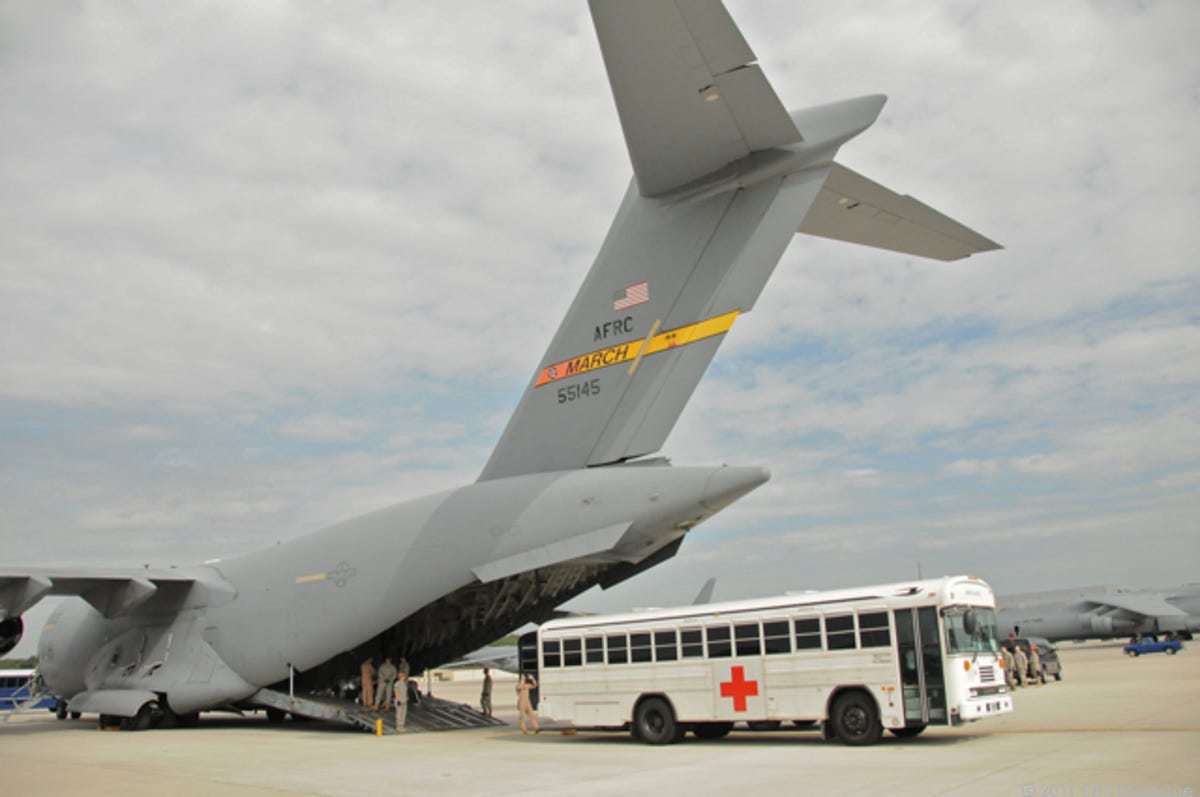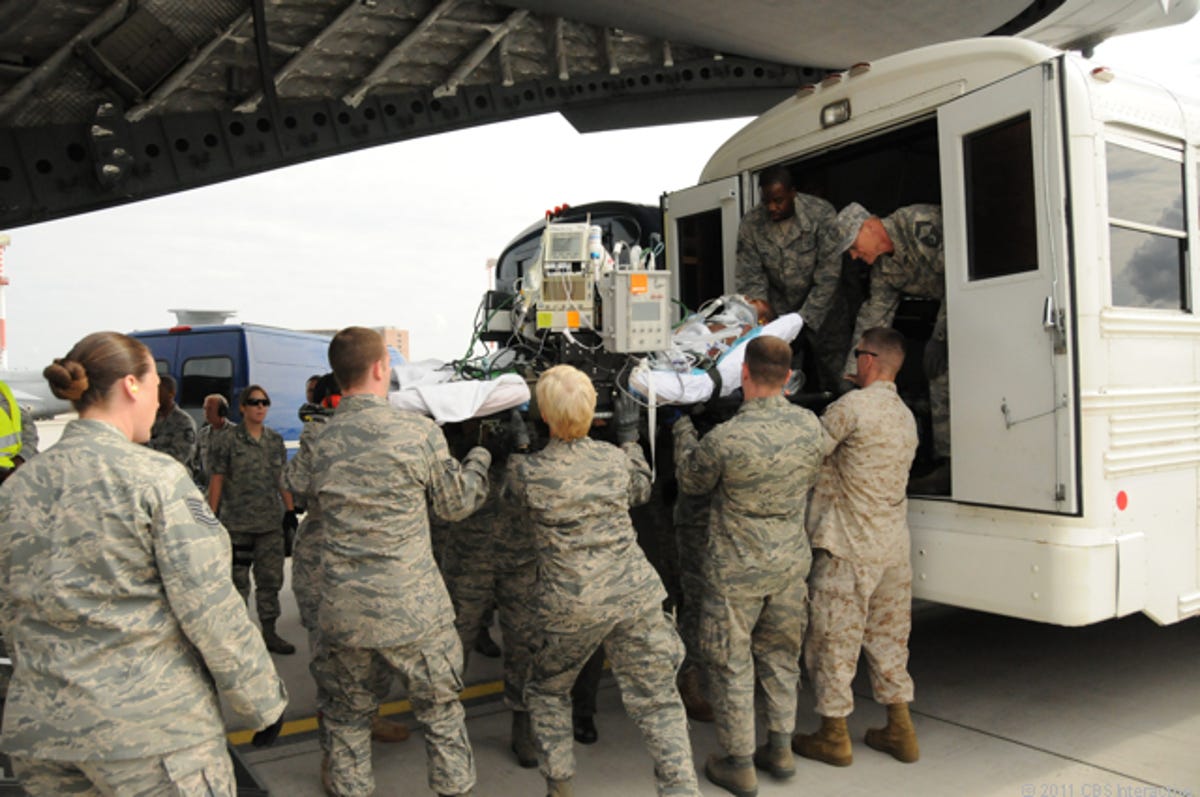Sending America's war wounded home (photos)
Road Trip 2011: At Ramstein Air Base in Germany, crews work tirelessly to take care of even the most badly injured.

Ambulance arrives at landed C-17
RAMSTEIN AIR BASE, Germany--When soldiers are too badly injured in Afghanistan or Iraq to be treated in the war zone, they must be taken elsewhere to heal. The first stop for most is this Air Force Base, which is also the "gateway to Europe" for most soldiers.
The first step for wounded soldiers is to be sent to Ramstein. If they need a quick treatment, they can get it there, and then be sent back to the theater. But if they need further care, they are often first stabilized at the Landstuhl Regional Medical Center near here and then sent back to a hospital in the United States.
Some soldiers being sent back to the U.S. will heal fairly quickly, or at least do not face life-threatening injuries. But others face long recoveries, especially those who have suffered lost limbs or traumatic brain injury.
Crews at Ramstein are trained to handle the patients as they arrive on the plane from the war zone, to help them while in Germany, and then to put them back on the plane for home.
Here, an ambulance pulls up to a C-17 that has just arrived from Iraq carrying several severely wounded, as well as other less wounded, soldiers.
Bringing out litter patient
Here, a crew from the 86th Contingency Aeromedical Staging Facility (CASF) carry a wounded soldier off the C-17. Though seriously injured, this soldier is not in as dire a situation as others on the plane. He is what is known as a "litter" patient, meaning he is carried on a cot and doesn't require special equipment. The most serious cases, those that need intensive care, require what is known as a Critical Care Air Transport Team (CCATT), a team of three specialists who travel with the patient and who carry all the gear needed to tend to him or her while in the air.
Taking CCATT patient off the plane
Here, the CASF crew carefully carries a CCATT patient off the C-17. These patients must be cared for at the Landstuhl Regional Medical Center until they are stable enough to be sent to a hospital in the United States. You can see all the gear required to care for the patient.

Lifting CCATT patient into ambulance
Counting gear required to care for the patient, the CASF crew must carry between 400 and 500 pounds when transferring him or her between the airplane and the ambulance. Here, it takes a group to lift this soldier onto the ambulance.
C-17 after all patients are out
After all the patients--both CCATTs and others--have been taken off the C-17, it is nearly empty. This plane, like all others being used for aeromedical evacuations to Ramstein, is a cargo plane that can be configured for many different uses. Ramstein has the ability to call for an airplane at any time for an evacuation, regardless of one of the regular flights scheduled to fly there is ready to go. The pilots who fly there are trained to fly several different kinds of airplanes.
Offloading patient luggage
Here, the CASF crew works to take patients' luggage off the C-17 that has just arrived at Ramstein from Iraq. The red cross tag on the bag seen here means that it belongs to a patient who was flown to Ramstein on the plane.
CASF beds male
Many of the less serious medical cases generally spend just one night at Ramstein before being flown home to the United States. The CASF maintains two rooms of 25 beds, one for men, and another for women. This is the men's room.
CASF team lined up
Here, we see the CASF team lined up to help lift patients from an ambulance onto a C-17 that is waiting to take them back to the United States.
Thumbs up for next patient
Here, we see Air Force Maj. Mick LuCore, the medical team director, giving the thumbs-up that means the CASF crew can bring another patient off the ambulance and on to the C-17.
Jameson onto plane, thumbs-up
Army Specialist Jameson Read, who was shot in the arm in Afghanistan, gives a thumbs-up as he is loaded on to the C-17 that will fly him home for a few weeks of physical therapy. He will then be sent back into combat.
Jameson gets his cookies
Volunteer members of the USO (United Service Organizations) based at Ramstein often make cookies to send with the soldiers who are flying to hospitals back in the United States. Here, a USO volunteer hands Specialist Jameson Read his bag of cookies on board the C-17.
Taking CCATT patient off the bus
Here we see the CASF team lifting a CCATT patient off the ambulance in order to take him on to the C-17 that will fly him to a hospital in the United States.
General Ellington talking to wife
In this photograph, taken on board the C-17 that is about to leave Ramstein for the United States, we see Air Force Maj. Gen. John Ellington, who is also chief of chaplains in the National Guard Bureau, talking with Larissa Daniel, whose husband has suffered a traumatic brain injury, and whose prognosis is unknown.
Medallion
Larissa Daniel shows the National Guard Bureau coin given her moments earlier by Gen. Ellington. The coin is meant to convey to her that she is not alone as she cares for her stricken husband.
Going over the plan
The CASF team goes over the game plan as they prepare to begin loading patients from two ambulances onto the C-17 that is about to take off from Ramstein for the United States.
Placing CCATT patient
Here, a CCATT patient is carefully placed into the rack aboard the airplane where he will lay during his flight back to America.
Real World CASF mission
A sign in the window of the ambulance indicates that the CASF team is not involved in a drill. This involves injured soldiers, and the team's mission is to care for them as best they can.
Patient information white board
This whiteboard in the CASF center conveys crucial information to the soldiers who are spending the night there before being flown home the next day.
Special quilt
A group called Quilts of Valor often makes special quilts for the wounded soldiers, and many of them take the quilts home with them. Here, we see one folded over the legs of a soldier being carried aboard the C-17.
CCATT kit on the plane
For every three CCATT patients, one CCATT team consisting of a physician, a critical care nurse, and a respiratory care therapist flies with them. The team will also bring all the gear needed to give in-flight treatment to the patients. Here, we see one of the CCATT kits aboard the airplane.
CCATT kit ready to go
The CCATT teams also maintain full sets of their gear in a storage area so that the equipment is ready to go at a moment's notice.
Dog signed
In the CASF center, there is a large poster signed by many of the patients who have spent time there. Among those patients is a working dog, who was injured in a fall. The dog was actually given a military rank, and it was the same as the animal's handler. The military sent the dog home, and the handler has been trying to adopt it.
Information on the fish
For three years since Army Sgt. Jesse Ault died in combat in Iraq, members of the 332nd Expeditionary Medical Group there have been trying to send Ault's beloved fish back to his family. Now, the fish are finally being sent home after volunteers raised enough money to get a veterinary certificate allowing the animals to be sent to the United States. This packet contains all the critical details about the fish.
Fish
This is one of the two fish being sent back to Sgt. Ault's family in the United States. The two fish were put on the C-17 that left Ramstein on June 10, 2011.
USO computers
At the Ramstein CASF center, the USO maintains a group of computers outfitted with Skype so that soldiers staying there can call their loved ones back home.

